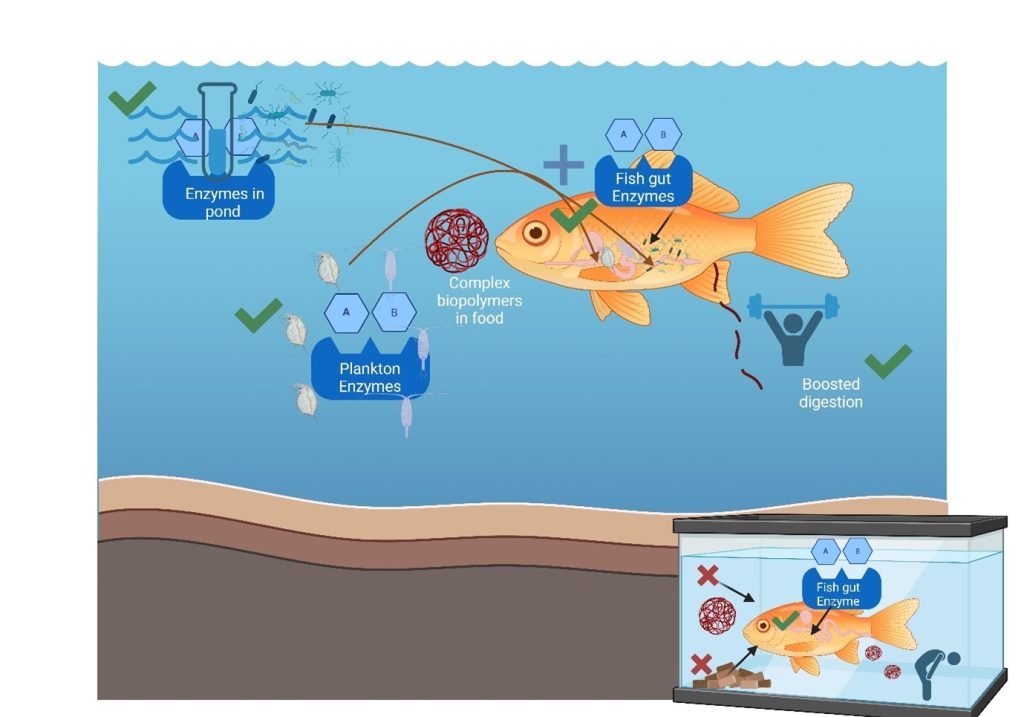
The scientific team from the Faculty of Fisheries and Protection of Waters of the University of South Bohemia in České Budějovice led by Jan Mráz, has made significant discoveries in the field of fishpond management and fish nutrition in the ponds.
Thanks to a GACR Standard project 22-18597S, they have discovered that the natural food and ecosystem in ponds can significantly improve the digestion of carps. Specifically, plankton and the pond environment work together to break down tough foods such as cellulose, chitin, and phosphorus in the fish’s stomach. Interestingly, during periods when the water is clear and low in algae but high in tiny zooplankton, carp digestion improves even more. This “Synergistic Digestibility Effect,” theorized in 2022 and confirmed in the researchers’ current study, could help manage fishponds more efficiently in the future (Fig 1).

Fig. 1: (BioRender JA26MXISBO)
Another discovery revealed how fish manage phosphorus in shallow lakes, which has a significant impact on algae growth. In a feeding state (active metabolism), fish typically balance their nutrient levels by releasing excess nitrogen and phosphorus, benefiting algal growth.
Fish can store more phosphorus and supply less to algae when the food base is selectively rich in lysine + methionine in overall intake protein and non-protein energy (i.e., carbohydrate and lipid energy share in overall intake energy). To the extent that there could be potential phosphorus absorption from water. Conversely, a lack of these nutrients in the food base leads to increased phosphorus release by fish, promoting algal growth. Scaly fish tend to recycle less phosphorus for algae than scaleless fish.
Their research suggests that not all carbon, nitrogen, or phosphorus in aquatic food webs are equally important for predicting phosphorus recycling by fish. Certain forms of nitrogen or carbon are more influential in regulating phosphorus levels. Balancing fish diets artificially and maintaining stocks of scaly fish might offer future solutions for managing eutrophication. For a deeper dive into the findings of Associate Professor Mráz and his team, read the full study published in the journal Science of The Total Environment (Fig 2).

Fig. 2: (BioRender MQ26VEPQTJ)
These findings from the GACR project 22-18597S are a significant step forward in the realm of nutritional ecology of aquatic consumers and the ecological stoichiometry theory of freshwaters. The findings are valuable for managing nutrient cycles and eutrophication of shallow lake ecosystems, including fishponds. The research team also respected open science practice, as the datasets were made publicly available with the publications.
Written by: Koushik Roy, Ph.D., doc. Antonin Kouba, Ph.D.
Roy, K., Kajgrova, L., Capkova, L., Zabransky, L., Petraskova, E., Dvorak, P., Nahlik, V., Kuebutornye, F.K.A., Blabolil, P., Blaha, M., Vrba, J. and Mraz, J., 2024. Synergistic digestibility effect by planktonic natural food and habitat renders high digestion efficiency in agastric aquatic consumers. Science of the Total Environment, 927, 172105. (IF 2023: 9.8). Linked Dataset.
Roy, K., Vrba, J., Kuebutornye, F.K., Dvorak, P., Kajgrova, L. and Mraz, J., 2024. Fish stocks as phosphorus sources or sinks: Influenced by nutritional and metabolic variations, not solely by dietary content and stoichiometry. Science of the Total Environment 938, 173611. (IF 2023: 9.8). Linked Dataset.